Reptiles & Amphibians in Westmoreland County PA
or nearby, & other critters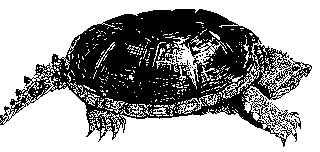
Snapping Turtle

As of June 10 for the year 2005 I've seen 5 dead Black Rat Snakes, all but one road kill. The exception was one seen in Packsaddle Gap that apperantly had been preyed upon and the tail end eaten off. Four road kill were seen in one day, June 10. Other roadkill seen June 10 while bicycling: 2 Porcupine, Canada Goose, Groundhog on Rt56 in Conemaugh Gorge. Live snakes seen so far in 2005: Timber Rattlesnake (Black and Yellow/Brown), Northern Watersnake, Queen Snake, Ring-necked Snake, Eastern Milk Snake, Northern Copperhead.
The winter of 2000-2001 was a long, cold winter. Lakes & ponds were frozen over for two months, from December and well into Feburary. The spring thaw came slowly. The timing for spring mating of amphibians came later than last year. A naturalist living in the Ligonier Valley had this to say in an email message dated April 4, 2001;
Things come late to the Ligonier Valley. My wood frogs have finally emerged and were in song this morning. To compare to last year, I first heard them on March 8! They are 3.5 weeks late.Wood Frogs can still be heard croaking in breeding pools as of April 7. I heard toads trilling last night for the first time this spring. Two friends, Frank & Kathy, their dog Bob - a 150 pound Great Dane - and I went to the Conemaugh River Lake the night of April 7, 2001 for hearing & seeing amphibians. We were there from 8pm until 11pm. It was a warm, summerlike night, with the temperature around 70 degrees (it had been in the 80s during the day) and a full moon. It was the first, summerlike warm/hot day we've had this spring. We heard & saw many Spring Peepers, including mating pairs, Wood Frogs, & saw Green Frogs. We also saw 13 Spotted Salamanders in shallow pools of water. The salamanders were from 7 to 8 inches in length, & chubby. It was a interesting excursion. We also saw one Garter Snake. Towards the end of our time at the lake clouds began rolling in, there were flashes of lightening behind distant hills, and the rumbling of thunder.
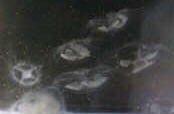 |
 |
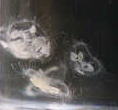 |
"C. sowerbii jellyfish are about the size of a quarter when fully grown. They are umbrella shaped and have a whorl of string-like tentacles around their circular edge. The tentacles have thousands of stinging cells that they use to capture their prey. The jellyfish are usually somewhat translucent, with a whitish or greenish tinge. Often, large flat sex organs hang from the underside of the jellyfish. These organs can make spotting the jellyfish easier since they are not translucent...are most often found in calm, freshwater lakes, reservoirs, man-made impoundments, and water-filled gravel pits or quarries. They can also be found in recreational fishing and boating areas. They have been seen in large river systems like the Allegheny River, the Ohio River, and the Tennessee River. The Jellyfish prefer standing water rather than currents. So, they generally are not seen in fast flowing streams or rivers...C. sowerbii jellyfish eat tiny, microscopic zooplankton that are found suspended throughout the water...Although, like other jellyfish, they have stinging cells, they cannot penetrate your skin. When would I see them? Usually late summer. August and September are the peak months for jellyfish sighting when lake water is very warm and food is abundant. The jellyfish will be floating or swimming gently just below the surface of the water. They are easily seen by the naked eye. They often surface in large numbers (called "blooms") in middle or late afternoon. Sunny days are especially good for spotting jellyfish."Links: IUP Jellyfish page | Hide & Seek Sea: Freshwater Jellyfish
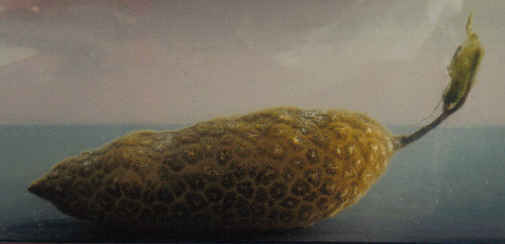 | A mass about 7 inches long attached to the stem of an aquatic plant. The photo was taken with the mass placed in a small aquarium. |
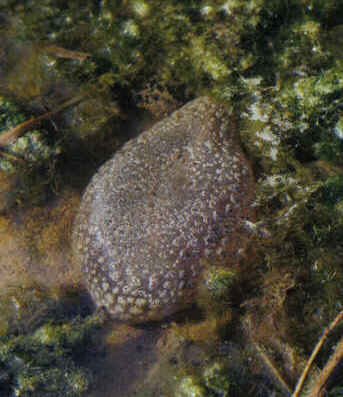 A free-floating mass in the lake near shore. | 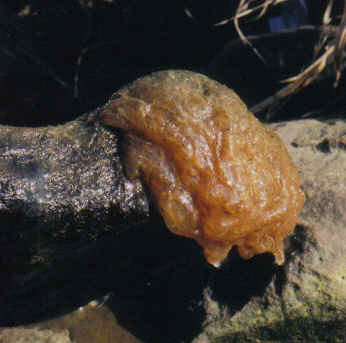 Mass attached to a rock that is lifted out of the water. |
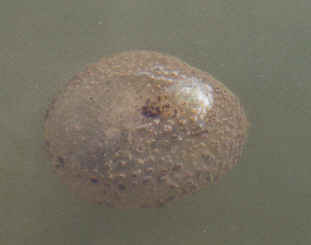 A free-floating mass near shoreline. The mass had been attached to probably a submerged branch at the center indentation. |
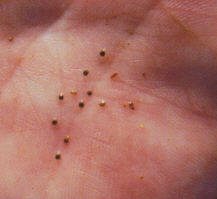 Statoblasts stuck to hand after handling a mass. |
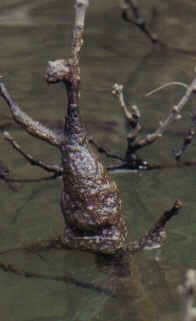 This photo of a mass attached to submerged tree limbs was taken at Loyalhanna Lake . The lake level had dropped exposing the mass to air. |
| The free-floating mass (had been attached), about 10 inches across. | 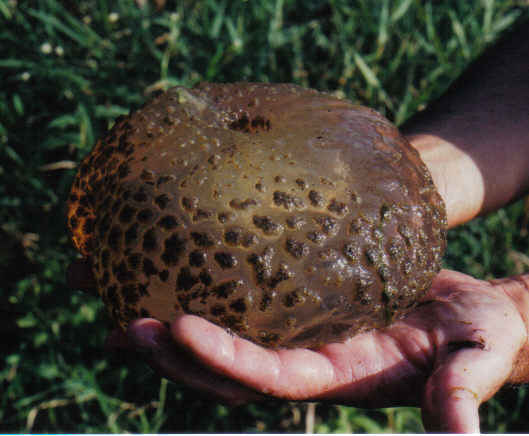 |
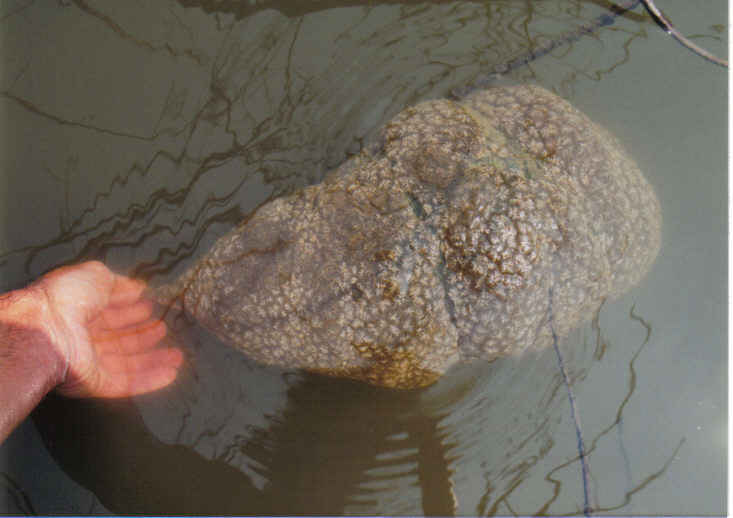
| Photos of bryozoa taken at Donegal Lake, August 5 2005: | |
|---|---|
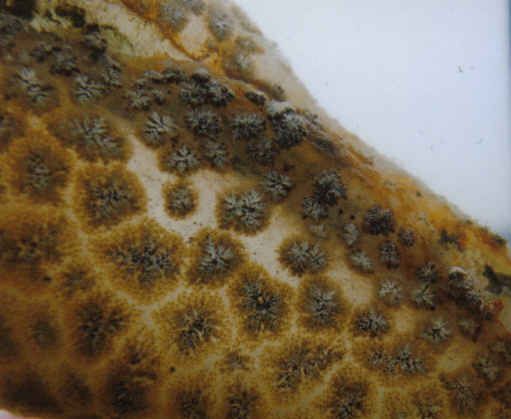 | Clusters of zoids. The photo magnification is not enough to show individual zoids. |
| Statoblasts (the darkest spots) are forming in the clusters of zoids. The translucent Zoids create a blur at the edges of the white formations. | 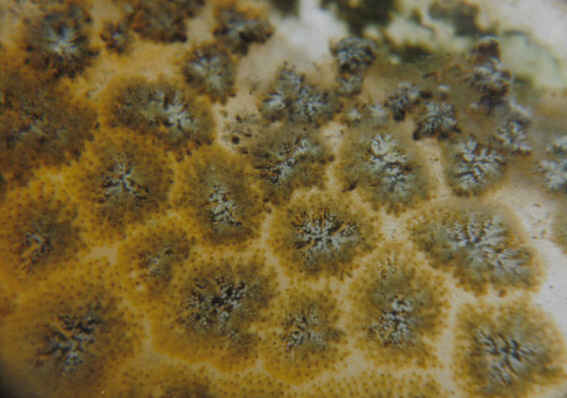 |
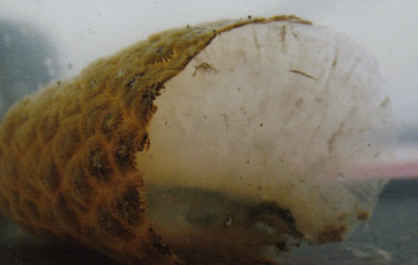 | The translucent gelatinous material upon which the colony resides. |
Links to some Bryozoan websites;
Bryozoa | Bryozoa | Bryozoa | Bryozoa | Bryozoa | Bryozoa | Bryozoa | Bryozoa
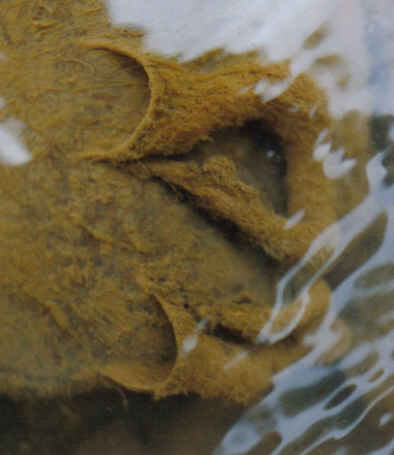 | Two tube-shaped silk capture nets, attached to a river rock, made by the aquatic larvae of a species of net-spinning Caddisfly. Net-building caddisfly larvae create silk nets to strain food material from river water. In the photo the open and closed ends of the net are attached to one another in the upstream direction, producing a downstream bend in the net. The open end of the nets are approximately 1 inch wide. In photo the river flow is from left to right. Caddisfly larvae spend the day under rocks, and move into the nets at night to feed. They also clean the nets. There are hundreds of species of Caddisfly in North America. Different species make different types of cases and nets. Photo taken at the Conemaugh River access at Bairdstown bridge, Blairsville, August 12 2005. Some links; Caddis-fly | Caddisfly | Caddisfly | Caddisfly |
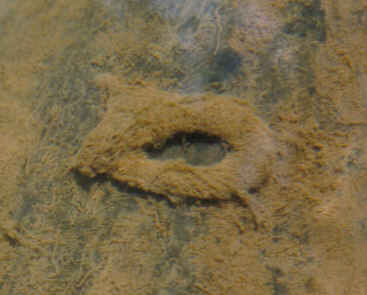 | Caddisfly silk tube capture net. The nets become coated with river silt. River flow is from left to right. |
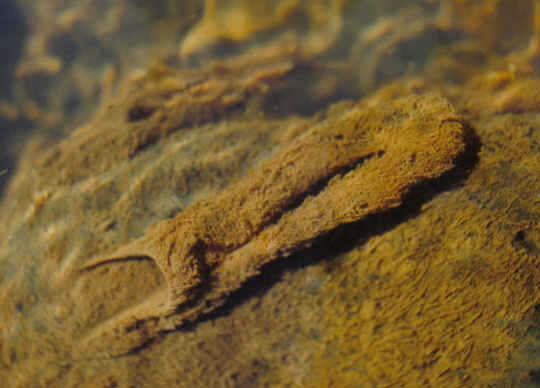 | Caddis-fly silk tube capture net. |
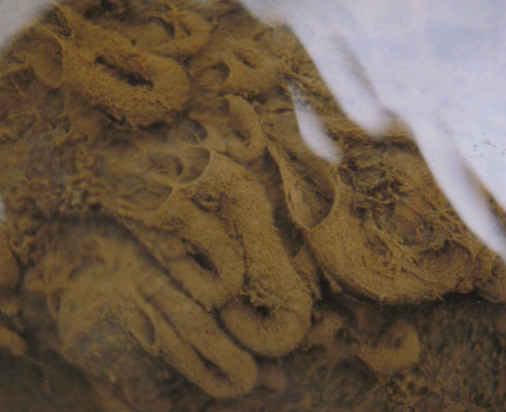 | Caddisfly nets clustered on a rock. |
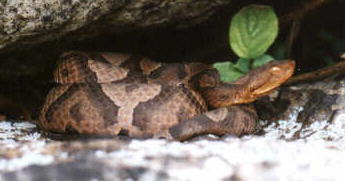 | 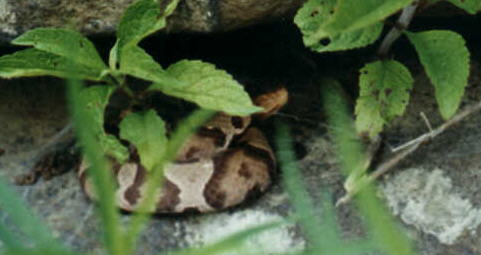 |
| Copperhead | |
On August 16 1995 I came upon a Timber Rattlesnake on a road in the mountains of sw PA. The snake started crossing the road then stopped, its length taking up about a third of the width of the narrow road. I parked my car, got out and directed other cars around the snake, making sure none ran over it. The snake showed no intentions of getting off the road so I prodded it with a stick, which made the snake curl itself into defensive coils. The snake never did rattle or strike, & eventually moved into the brush off the side of the road.
According to the range maps of Peterson's Field Guide to Reptiles and Amphibians there are 20 species of snake that can occur in southwestern PA (or come close):
1)Northern Water, 2)Queen, 3)Kirtland's, 4)Shorthead Garter, 5)Easter Garter, 6)Eastern Ribbon, 7)Northern Brown, 8)Northern Redbelly, 9)Mountain Smooth Earth, 10)Ringneck, 11)Eastern Hognose, 12)Eastern Worm (comes close to sw PA), 13)Smooth Green, 14)Rough Green (in extreme sw PA), 15)Northern Black Racer, 16)Black Rat Snake, 17)Eastern Milk Snake, 18)Northern Copperhead, 19)Eastern Massasaugas (nw PA, Pymatuning Lake & Senango River areas, Jennings Environmental Education Center), 20)Timber Rattlesnake. The Eastern King Snake's northern edge of range barely reaches into extreme southeastern PA.
Photos:
(Use your browser's Back button to return from the image)
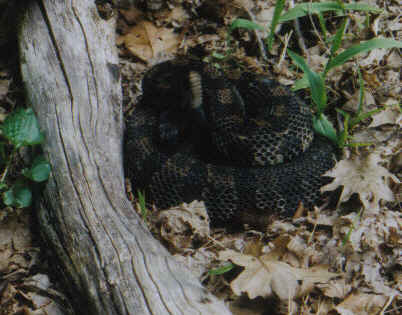 | May 2005. While walking forward with a camera to my face, looking thru the viewfinder adjusting the field of view for a landscape subject, I stopped to take a photo two steps short of this basking rattlesnake, without knowing the snake was there. Fortunately the field of view became satisfactory before I took two more steps to this rattler. The snake did not start rattling until later, warning and poised to strike (in self defense). It was a close call. I was wearing sandals on my feet. Moving to cover | Back to protection of cover | On the move. A different day at another location Yellow phase, Timber Rattlesnake, 2005. |
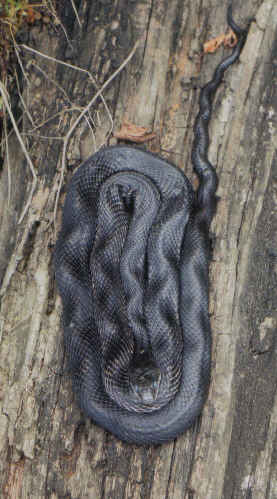 Black Rat Snake coiled snugly in the depression of a log. Loyalhanna Lake, Autumn 2004 | 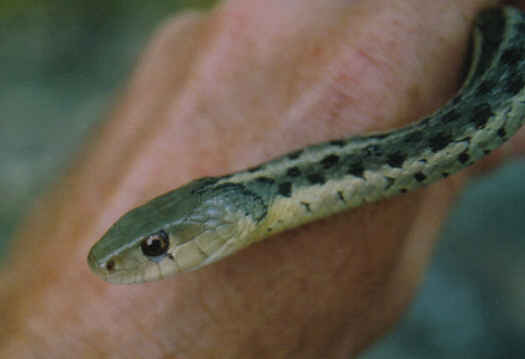 Garter Snake, Linn Run Holllow, July 2005. |
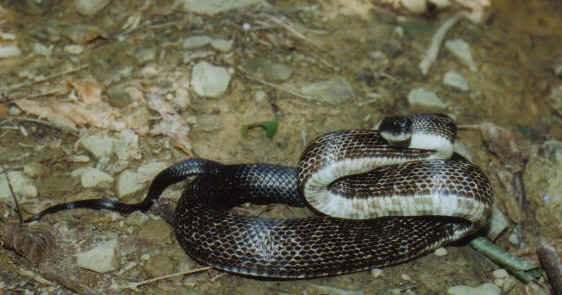 | Black Rat Snake in defensive posture ready to strike out. Its tail had been vibrating against leaf litter producing a buzzing sound similar to the sound of a Rattlesnake. Packsaddle Gap, September 2005. The pattern between the scales shows up well in this photo. |
Copperhead @ Ohiopyle May 2000.
Copperhead @ Ohiopyle May 2000.
Copperhead @ Loyalhanna Lake, August 1996.
Copperhead @ Ohiopyle August 14 1997.
Copperhead @ Ohiopyle June 6 1997. On a rock ledge a Copperhead might be easy to spot, but when laying amidst leafy ground litter it takes a practiced eye to discern the Copperhead's camouflaged form.
Copperhead @ Ohiopyle July 10 1996.
Eastern Milk Snake (40" long) on Rt381S on hill before Falling Water June 6 1997.
Eastern Milk Snake
Northern Water Snake, a young one, Loyalhanna Creek.
Black Rat Snake basking on a log at Loyalhanna Lake, Sept. 2003.
Black Rat Snake (5 feet long) caught at night in parking lot of the A-Plus Mini Mart on Lloyd Avenue in Latrobe July 1996. In this pic the snake is climbing a vertical stone wall alongside our driveway.
Black Rat Snake another sample of the Black Rat Snake's predisposition & skill at climbing.
Black Rat Snake enjoying a meal of a fresh roadkill Grackle.
Black Rat Snake with blue eyes before shedding skin.
Black Rat Snake in hand.
Black Rat Snake young one.
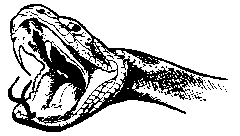
Two Timber Rattlesnakes, yellow & dark variations, August 8 1995. The two rattlers are intercoiled, their heads situated side by side, though the black head of the dark snake to the left is difficult to discern in the scanned image (the original photo is better). The images are in sequence as the snakes moved beneath the ledge I was on. They began to rattle in response to my presence as I leaned over the top of a cliff to take these photos:
Rattlesnakes 1 |
Rattlesnakes 2 |
Rattlesnakes 3 |
Rattlesnakes 4
The rattlesnake was a favorite symbol among pre-Revolutionary War colonists, particularly the more militant ones. The flag of Colonel John Proctor's battalion of the Westmoreland [County] Association used the coiled Rattlesnake motif with the motto "Don't Tread on Me". John Proctor's gravesite is in Unity Cemetery, just outside Latrobe, two miles from where I live. Unity Cemetery dates back to before the Revolutionary War.
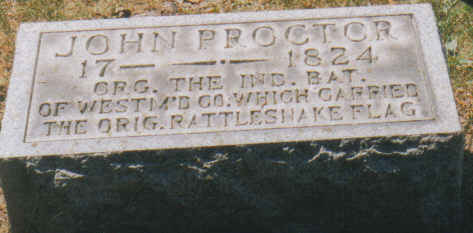 | John Proctor's grave marker in Unity Cemetery, Westmoreland County. Photo taken June 2005. The exact location of Proctor's grave isn't known, but it is in the old section of Unity Cemetery. Proctor's Rattlesnake Flag is in the William Penn Memorial Museum in Harrisburg. |
Snake bites:
Approximately 7,000 bites from poisonous snakes are reported annually in the United States, resulting in about 15 deaths, according to the Centers for Disease Control and Prevention. Most happen during the summer, and the majority are in the Southeast and Southwest. (source; Tribune-Review newspaper 7/19/2000 A3)
92 snakebites were reported in western Pennsylvania in 1999 - six rattlesnake bites, one copperhead, 54 nonpoisonous, 27 unidentified snakes and two poisonous exotic snakes. None were fatal. Not all snake bite victims are from rural areas, but also from snake owners, participants in snake hunts and snake sacking contests, and others. (source; Tribune-Review newspaper, 7-20-2000 pB1)
Treatment of venomous snake bite; www.fda.gov/fdac/features/995_snakes.html | www.emedicine.com/emerg/topic540.htm | topic2143.htm
Links: Pennsylvania Wildlife, includes a nice collection of PA wildlife photos.
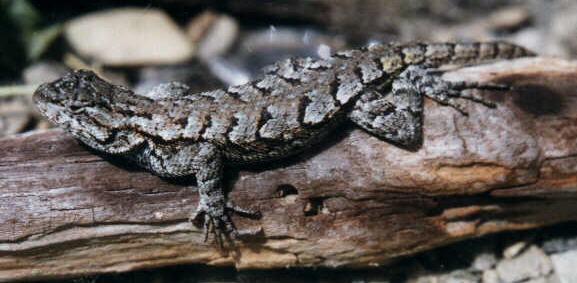
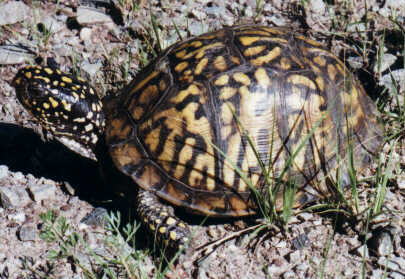
In June of 1994 a friend & I went to a bridge over the Loyalhanna Creek to investigate a commotion of noise from canada geese (we could hear the geese from his deck). We saw two families of geese along the shoreline frantic in their attempts to free a young goose that was trapped somehow by something in the water. Thinking the young goose had a foot caught in a leftover muskrat trap, or in a tangle of fishing line, I volunteered myself, wearing cutoffs & in bare feet, to wade into the mucky water to free the gosling. As I approached the gosling I was promptly confronted by the adult geese. They saw me as another threat. Large parent canada geese defending a young are something to contend with!! While trying to ignore their threatening overtures I proceeded to feel with my hands & feet (the water being too muddy to see into) what might be trapping the gosling. I could not feel any fishing line, so i moved my hands thru the muck in search of a muskrat trap. Couldn't feel a trap either. I began to wonder what it might be that had the goose so firmly caught. All I could feel was a rock underneath the gosling, or what I thought was a rock. When I began to lift the "rock" out of the water I soon found out the "rock" was, in actuality, a Snapping Turtle! The snapper had its jaw clamped firmly on one of the goslings legs. Not knowing what else to do I began pulling on the snappers tail, figuring to irritate the snapper into letting go. The snapper did let go, eventually, & I quickly got out of the water, a wet & muddy mess. But the gosling was freed, & happily joined the others. And the snapper, deprived of one meal, would have to find another meal somewhere else.
Unfortunately turtles are one of those groups of creatures that are especially impacted by the construction of roadways through or near their habitat. Every year I see Snapping Turtles & Box Turtles that are killed - run over by motor vehicles - when trying to cross a road. I once saw a Painted Turtle dead on the road near Keystone State Park (Painted Turtles usually don't travel far from water). To make matters even worse, highways are now built with concrete crash barriers between opposing lanes of traffic, trapping any creature attempting to cross the roadway, making it impossible for them to move from one part of their range to another. Not a good state of affairs for reptiles & amphibians, and becoming worse with every new road that is constructed, every highway that is "improved" with lane barriers.Frog Roadblock
Police in the southern Czech region of Moravia closed a busy road to give local frogs safe passage to their mating grounds. Traffic was diverted along a pond near the town of Brno, located 125 miles southwest of Prague, to protect the amorous amphibians from being killed by passing vehicles. Hundreds of frogs are killed in the Czech Republic each spring while migrating to mating areas. A special frog tunnel was opened in north Moravia last year to reduce the number of deaths.
-from Earthweek: A Diary of the Planet for the week ending 4/2/1999
The following links will open in a separate window:
1) Common Snapping, 2)Common Musk (nw & se PA), 3)Common Map, 4)Bog (nw PA), 5)Wood, 6)Spotted, 7)Midland Painted, 8)Box, 9)Midland Smooth Softshell, 10)Eastern Spiny Softshell.Photos:
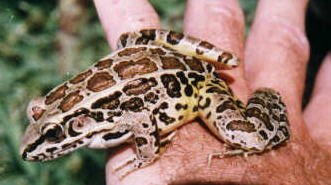
Frogs that can occur in Westmoreland County are American Toad, Fowler's Toad, Gray Treefrog, Chorus Frog (comes close; Western Chorus in extreme w PA, Upland Chorus in central PA), Northern Spring Peeper, Mountain Chorus Frog, Green Frog, Bull Frog, Northern Leopard Frog, Pickerel Frog, Wood Frog. Frogs I am most familiar with in the county are American Toad, Spring Peeper, Green, Bull, Pickerel, & Wood.
On August 15 2005 along the Loyalhanna Creekside trail in Latrobe I heard what sounded like the bleating of a fawn White-tailed Deer calling to its mother. Following the sound to a thicket of Japanese Knotweed I found the source of the sound to be a Bullfrog struggling with its left rear foot stuck in the mouth of a Gartersnake.
  Spring Peeper can fit on a quarter |
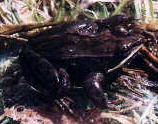 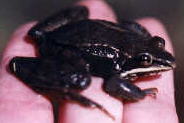 Wood Frog note white stripe on upper jaw |
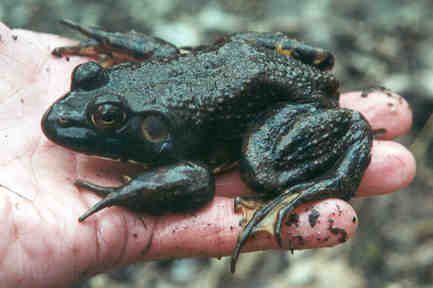
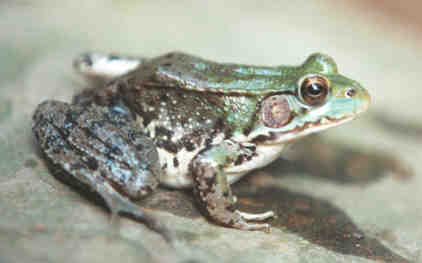
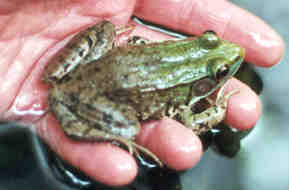
Below three frog pictures taken in Crisfield, MD after a summer shower that followed a dry spell, July 2007. Green Tree Frog, Fowler's Toad, Gray Tree Frog.
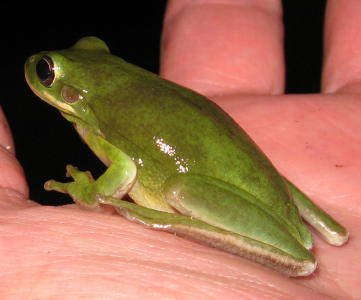
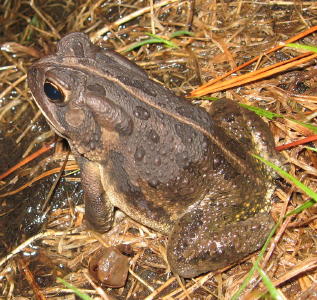
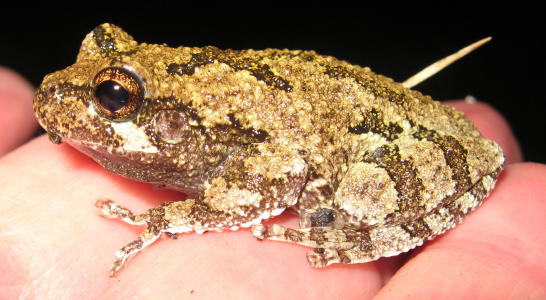 Above three pictures taken in Crisfield, MD after a summer shower that followed a dry spell, July 2007.
Above three pictures taken in Crisfield, MD after a summer shower that followed a dry spell, July 2007.
1)Eastern Hellbender, 2)Mudpuppy, 3)Red-spotted Eastern Newt, 4)Jefferson, 5)Spotted, 6)Marbled, 7)Northern Spring, 8)Mountain Dusky, 9)Northern Dusky, 10)Seal, 11)Green, 12)Northern Red, 13)Northern Slimy, 14)Ravine, 15)Valley & Ridge, 16)Wehrle's, 17)Redback, 18)Four-toed, 19)Northern Two-lined, 20)Longtail
Photos by Tim Vechter copyright ©1999-2005.
For more images go here